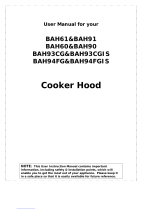
SAFETY INSTRUCTIONS
•Thank you for purchasing this cooker hood. Please read the instruction manual
carefully before you use the cooker hood, and keep it in a safe place.
• The installation work must be carried out by a qualied electrician or competent
person. Before you use the cooker hood, make sure that the voltage (V) and the
frequency (Hz) indicated on the cooker hood are exactly the same as the voltage
(V) and the frequency (Hz) in your home.
• The manufacturer and the agent will not bear any responsibility for the damage
caused by inappropriate installation and usage.
• Never let children operate the cooker hood.
• The cooker hood is for home use only. It is not suitable for barbecues, Roast shop
and commercial purposes.
• The cooker hood and its lter mesh should be cleaned regularly in order to keep it
in good working order.
• Before cleaning, switch the power off at the main supply.
• Clean the cooker hood according to the instruction manual and keep the cooker
hood from the danger of burning.
• Prohibit putting the cooker hood by re.
• If there is any fault with the appliance, please call the service department to request
a service engineer.
•This appliance can be used by children aged from 8 years and above and persons
with reduced physical, sensory or mental capabilities or lack of experience and
knowledge if they have been given supervision or instruction concerning use of
the appliance in a safe way and understand the hazards involved. Children shall
not play with the appliance. Cleaning and user maintenance shall not be made by
children without supervision.
•If the supply cord is damaged, it must be replaced by the manufacturer, its service
agent or similarly qualied persons in order to avoid a hazard.
• The instructions shall state the substance of the following: there shall be adequate
ventilation of the room when the range hood is used at the same time as appliances
burning gas or other fuels (not applicable to appliances that only discharge the air
back into the room).
•Do not ambé under the range hood. Accessible parts may become hot when used
with cooking appliances.
Important Hints on Installation
•The air must not be discharged into a ue that is used for exhausting fumes from
appliances burning gas or other fuels (not applicable to appliances that only
discharge the air back into the room).
•Regulations concerning the discharge of air have to be fullled.
Page 2














